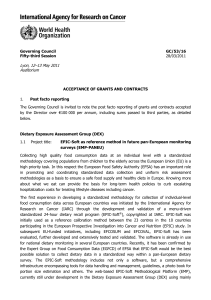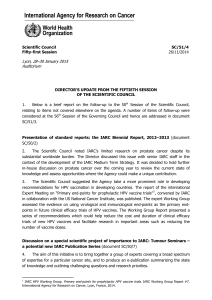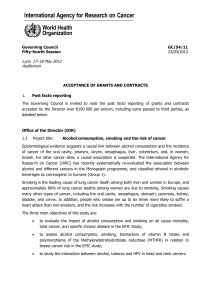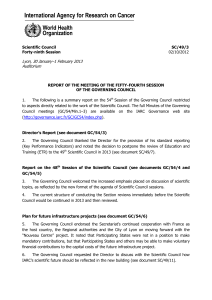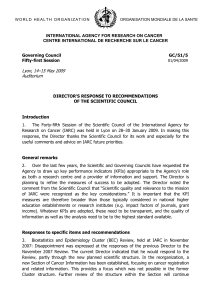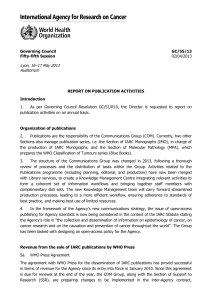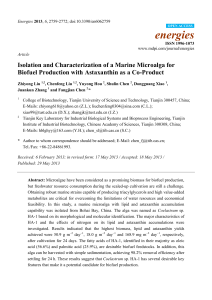Lyon, 15–16 May 2014 Auditorium
publicité
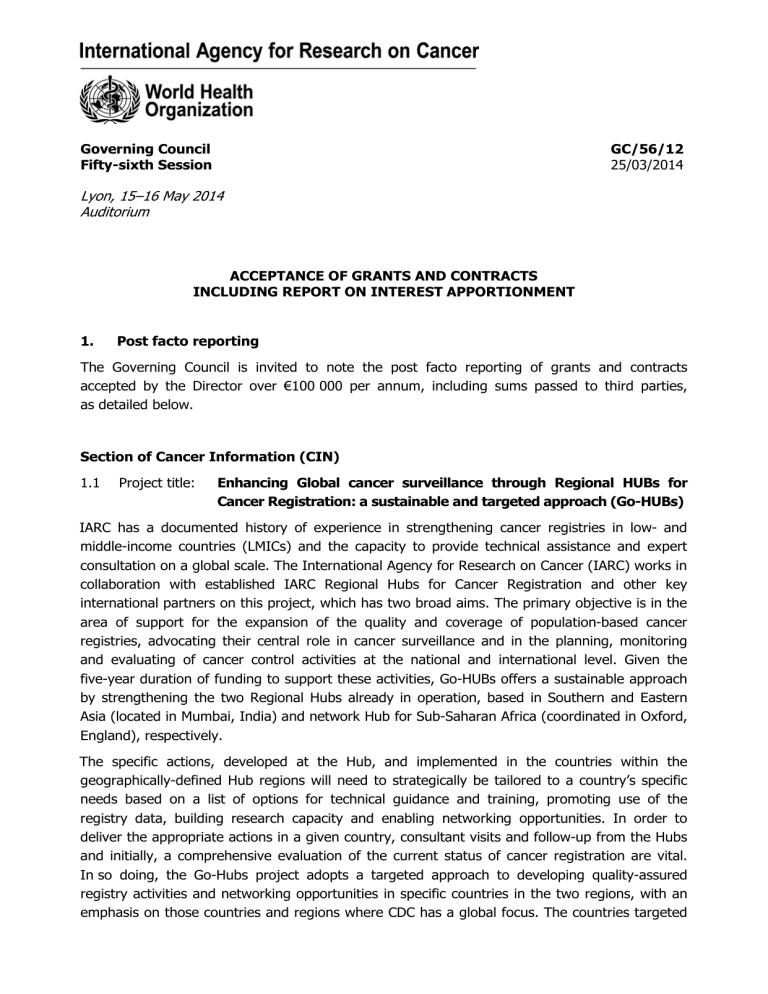
Governing Council Fifty-sixth Session GC/56/12 25/03/2014 Lyon, 15–16 May 2014 Auditorium ACCEPTANCE OF GRANTS AND CONTRACTS INCLUDING REPORT ON INTEREST APPORTIONMENT 1. Post facto reporting The Governing Council is invited to note the post facto reporting of grants and contracts accepted by the Director over €100 000 per annum, including sums passed to third parties, as detailed below. Section of Cancer Information (CIN) 1.1 Project title: Enhancing Global cancer surveillance through Regional HUBs for Cancer Registration: a sustainable and targeted approach (Go-HUBs) IARC has a documented history of experience in strengthening cancer registries in low- and middle-income countries (LMICs) and the capacity to provide technical assistance and expert consultation on a global scale. The International Agency for Research on Cancer (IARC) works in collaboration with established IARC Regional Hubs for Cancer Registration and other key international partners on this project, which has two broad aims. The primary objective is in the area of support for the expansion of the quality and coverage of population-based cancer registries, advocating their central role in cancer surveillance and in the planning, monitoring and evaluating of cancer control activities at the national and international level. Given the five-year duration of funding to support these activities, Go-HUBs offers a sustainable approach by strengthening the two Regional Hubs already in operation, based in Southern and Eastern Asia (located in Mumbai, India) and network Hub for Sub-Saharan Africa (coordinated in Oxford, England), respectively. The specific actions, developed at the Hub, and implemented in the countries within the geographically-defined Hub regions will need to strategically be tailored to a country’s specific needs based on a list of options for technical guidance and training, promoting use of the registry data, building research capacity and enabling networking opportunities. In order to deliver the appropriate actions in a given country, consultant visits and follow-up from the Hubs and initially, a comprehensive evaluation of the current status of cancer registration are vital. In so doing, the Go-Hubs project adopts a targeted approach to developing quality-assured registry activities and networking opportunities in specific countries in the two regions, with an emphasis on those countries and regions where CDC has a global focus. The countries targeted Governing Council Acceptance of grants and contracts, including report on interest apportionment GC/56/12 Page 2 for support are: Thailand and Vietnam within Southern and Eastern Asia, and Kenya, Tanzania, Zambia, Botswana, and Rwanda in Sub-Saharan Africa. These activities will be undertaken in conjunction with the Hub Principle Investigators (Drs Rajesh Dikshit and Max Parkin in Mumbai and Oxford, respectively). Provision will also be made for the necessary technical exchanges between CDC, IARC and the Hubs to help inform CDC’s priority cancer activities. The specific objectives are: i) to provide the foundations for a sustainable development of Regional Hubs for Cancer Registration in Sub-Saharan Africa and South, Central and Eastern Asia; ii) to develop a sustainable Registry Network for Southern and Eastern Asia (involving the Asian Pacific Journal of Cancer Prevention Editor, Dr Malcolm Moore); iii) to develop a sustainable Regional Hub model for Sub-Saharan Africa; and iv) to identify the needs and provide measurable improvements in the coverage, quality and national networking capacity in the eight targeted countries in Southern and Eastern Asia and Sub-Saharan Africa, as specified above. Donor: Centers for Disease Control and Prevention (CDC), USA Duration: 60 months Funds for IARC: €176 338 (US$ 233 870) Funds for partners: €366 382 (US$ 485 918) Total: €542 720 (US$ 719 788) Partners: African Cancer Registry Network (AFCRN), UK €241 670 (US$ 320 518) Tata Memorial Centre, India €113 402 (US$ 150 400) Asian Pacific Journal of Cancer Prevention, Thailand €11 310 (US$ 15 000) 1.2 Project title: Contribution in support of IARC scientific and technical contribution and training for Cancer Registration in the Latin America Regional Hub As part of its remit, IARC promotes and enables the continued expansion and improvement in the extent and quality of cancer registration in LMICs. To ensure the appropriate capacity and expertise relative to the scope and ambition of this undertaking, a key instrument is the development of a number of regionally-based resource centres (IARC Regional Hubs for Cancer Registration) in Africa, Asia and Latin America. With IARC maintaining a coordinating role, the aim of such Hubs is to provide the necessary support, advocacy, consultancy and training for those working in the field of population-based cancer registration within these designated regions. The envisioned model for GICR implementation in the LAC region (Latin America and the Caribbean) is based on “Network Hubs”, a model which is currently being piloted in sub-Saharan Africa. With regard to Central and South America (hereafter “Latin America”), after discussions with the Latin American Network of National Cancer Institutes (RINC), it has been decided that the Regional Hub would be located in Buenos Aires. The Latin American Regional Hub will serve to provide administrative and technical support to the delivery of training, as the focal point of the registry community in the region, responding to initial queries and liaising with IARC to assess and identify priorities and needs. Network Hub activities include technical support to registries regarding population-based registration methods, GC/56/12 Page 3 Governing Council Acceptance of grants and contracts, including report on interest apportionment coding and classification; regarding installation, data management, quality control and data analysis using CanReg5; regarding support to quality assurance and publication of data. Donor: Dutch Cancer Society, the Netherlands through Union for International Cancer Control (UICC), Switzerland 12 months €92 125 (US$ 125 000) €36 850 (US$ 50 000) €128 975 (US$ 175 000) Duration: Funds for IARC: Funds for partners: Total: Partners: Latin American Network of National Cancer Institutes (RINC), Argentina €0 (US$ 0) National Cancer Institute (INC), Argentina €36 850 (US$ 50 000) 1.3 Project title: IARC-WHO Action Plan in the areas of cancer surveillance and risk factors This project proposes an initial programme of work to follow-up on some of the specific priority areas identified at the recent EMRO-IARC Regional Meeting on Cancer Control and Cancer Research in Doha (20–22 October 2013). The main objectives are: 1) Finalize the situational analysis of cancer registration across the countries of the Eastern Mediterranean Region (EMR) and initiate the provision of training and capacity building; and 2) Collate the available data on cancer burden and risk factors for an analysis of the population attributable fraction of cancers associated with major risk factors across the EMR countries. To achieve these objectives, three activities are planned: 1) Training and networking workshop for the 23 EMRO countries: expanding and sustaining high quality cancer surveillance systems across the region. A four-day course will identify 23 participants (one per country) and a host country for the course in the region (Cairo). An international Faculty comprising of IARC, the applicable IARC Regional Hubs and local experts within EMRO will be assembled. 2) Site visits to selected countries in the EMR at differing levels of resource and registry development: a model for engagement and action. Following the situation analysis, three levels of countries within the EMR, based on levels of human development and registry status, have been identified. Site visits will be conducted as a means to identify key areas of resourcedependent activity, while acknowledging the varying health systems, resources and commitments to cancer control and cancer surveillance across the countries at every level of resource. Egypt, Morocco and Iran will be initially visited. 3) Fundamental to cancer control priority setting in the region are an understanding of the contribution which different risk factors make to the cancer burden and an assessment of the potential impact of different preventive interventions. The third part of the current work plan is to conduct baseline work needed for such an exercise. First, IARC will work with cancer registries across the region to produce a report and peer-reviewed paper entitled “The changing scale and profile of cancer in the Eastern Mediterranean: the need for action”. The results will be based on an original descriptive analysis of the registry incidence data and the geographical and temporal variations observed across the 23 countries. The findings are interpreted in relation to the status of cancer control plans and the need to implement cost-effective cancer Governing Council Acceptance of grants and contracts, including report on interest apportionment GC/56/12 Page 4 control actions according to the magnitude and profile of cancer and the level of resource in a given country. This exercise will also provide the cancer burden data needed for an assessment of population attributable fractions (PAF) of cancer related to the major risk factors in the region (including tobacco, diet, obesity and infection). Second, a PAF working group will be established between IARC and scientists from EMR countries to consider the various methodologies and differing datasets available on risk factor prevalence and levels. This group will develop an overall framework for PAF estimates using standardized approaches. The working group will examine the quality of information available from the national surveys of risk factors, identify gaps and liaise with other country representatives to gather further data for a formal analysis. Donor: Duration: Funds for IARC: Funds for partners: Total: Partners: 1.4 Project title: World Health Organization, Regional Office for the Eastern Mediterranean (EMRO), Egypt 8 months €145 200 (US$ 200 000) €145 200 (US$ 200 000) n/a Global Initiative for Cancer Registry Development in Low- and middle-income Countries and IARC 2013 Registry Training Course As part of its remit, IARC promotes and enables the continued expansion and improvement in the extent and quality of cancer registration in LMICs. To ensure the appropriate capacity and expertise relative to the scope and ambition of the undertaking, a key instrument is the development of a number of regionally-based resource centres (IARC Regional Hubs for Cancer Registration) in Africa, Asia and Latin America. This contribution is in support for four Hubs established or nearly established in Mumbai, Izmir, Buenos Aires and the Hub network in Sub-Saharan Africa. Hub activities include technical support to registries regarding population-based registration methods, coding and classification; regarding installation, data management, quality control and data analysis using CanReg5; regarding support to quality assurance and publication of data. In addition, the funding supported participants and faculty for the cancer registry course IARC organized in Izmir from 30 September to 4 October 2013 in collaboration with the European Commission’s Joint Research Centre (JRC) and the Middle East Cancer consortium. Donor: Duration: Funds for IARC: Funds for partners: Total: Partners: National Institutes of Health/National Cancer Institute (NIH/NCI), USA 12 months €164 590 (US$ 218 000) €164 590 (US$ 218 000) n/a GC/56/12 Page 5 Governing Council Acceptance of grants and contracts, including report on interest apportionment Epigenetics Group (EGE) 1.5 Project title: To identify mechanism-based biomarkers for aflatoxin-induced child stunting that can be applied to improve child health in countries with a high burden of aflatoxin exposure Aflatoxin (AF) is a carcinogenic mycotoxin that is a common dietary contaminant and is causing severe public health and economic burdens in many parts of sub-Saharan Africa. We have previously shown that there is an association between child stunting and AF exposure but the mechanism for this is not known. In this proposal we will explore two possible mechanisms by which exposure to AF impairs child growth in early life (up to 24 months); 1) taking a global epigenetic and transcriptome approach to explore pathways and identify epigenetic and gene expression markers of AF associated impaired child growth in general, and 2) understanding the impact of reduction of Insulin like Growth Factor (IGF) axis proteins on child stunting as a direct result of AF induced liver toxicity. Identifying the mechanism by which AF induces child stunting, and providing validated markers from the mechanistic pathway that are altered by AF exposure, will enable future work aimed at mitigating the effects of AF on child growth. In phase one, the project will involve initial laboratory work with AF treated human liver cell line and blood samples from an established child cohort – the Early Nutrition and Development (ENID) cohort in the Gambia where AF exposure has been well characterized, to identify candidate biomarkers on the mechanism pathway that AF affect child stunting from the epigenetic and transcriptome study and the analysis in IGF axis protein levels (for which we already have preliminary in vitro experimental data). AF exposure biomarker and child growth parameters will also be measured at several time points in these children in order to select and verify the effective mechanism marker(s). In phase two, the markers identified from phase one as having good potential as mechanistically relevant biomarkers will be validated on a subset of high and low exposed children from the ENID cohort and then used in a proof of concept study to evaluate the performance of the markers in an intervention study by replacing the contaminated groundnut with clean food. Donor: Bill and Melinda Gates Foundation, USA, through The Queen’s University of Belfast, UK 24 months €229 652 (US$ 304 175) €651 945 (US$ 863 504) €881 597 (US$ 1 167 679) Duration: Funds for IARC: Funds for partners: Total: Partners: The Queen’s University of Belfast, UK €315 318 (US$ 417 640) University of Leeds, UK €222 134 (US$ 294 217) Medical Research Council, UK €114 493 (US$ 151 647) Governing Council Acceptance of grants and contracts, including report on interest apportionment GC/56/12 Page 6 Section of Environment and Radiation (ENV) 1.6 Project title: African Breast Cancer Research Network – Disparities in Outcomes (ABC-DO) Low survival rates from breast cancer in sub-Saharan Africa need to be addressed, especially given that the incidence burden is increasing. We will conduct the first in-depth multi-country sub-Saharan African study of the full journey of breast cancer patients. In public hospitals in Nigeria (West Africa), Uganda (East Africa), South Africa and Namibia (Southern Africa), 1800 newly diagnosed breast cancer patients will be invited to participate in ABC-DO. The four public hospital settings have been chosen to span a range of urban/rural and concentrated/dispersed catchment populations as well as contrasting health systems. Patients will be interviewed at diagnosis and will be followed up for up to three years, during and after their breast cancer treatment. We will assess factors influencing delayed diagnosis, and timely treatment access, adherence, side-effects, recurrence and, ultimately, survival. Africa’s high mobile ownership rates will enable such follow-up through three-monthly calls to mobile phone of the patient or their next-of-kin. The full patient journey, from first palpable tumour, to diagnosis and post-treatment will be dissected and the personal, cultural, socioeconomic, clinical and health system factors influencing all segments of the patient’s journey will be investigated. Donor: Susan G. Komen for the Cure (Komen Foundation), US Duration: 48 months Funds for IARC: €518 619 (US$ 704 646) Funds for partners: €193 420 (US$ 262 799) Total: €712 039 (US$ 967 445) Partners: Chris Hani Baragwanath Academic Hospital, South Africa €63 063 (US$ 85 684) Windhoek Central Hospital, Namibia €50 913 (US$ 69 175) Abia State Hospital, Nigeria €26 805 (US$ 36 420) Mulago Hospital, Uganda €52 639 (US$ 71 520) London School of Hygiene and Tropical Medicine (LSHTM), UK €0 (US$ 0) 1.7 Project title: COSMOS in France: Cohort Study of Mobile Phone Users Several public health authorities have recommended conducting a prospective cohort study of mobile phone users to address open questions related to adverse health effects associated with mobile phones or other wireless technologies. Such a study has been recently launched in five European countries (Cosmos study: Denmark, Finland, Sweden, the Netherlands, and the United Kingdom) and during the conduct of a feasibility study it was determined whether France could be a sixth country, complying with the international study protocol and adding another study population to, firstly, have sufficient statistical power to detect possible risks of rare diseases and, secondly, investigate exposure distributions and health risks of common endpoints under French conditions. GC/56/12 Page 7 Governing Council Acceptance of grants and contracts, including report on interest apportionment The present proposal defines the study design, recruitment, exposure assessment, and followup of the French arm of Cosmos. Key design feature is to invite participants already enrolled into another French prospective cohort study, namely Constances, by providing an extra questionnaire and approval to obtain the cumulative mobile phone use through traffic records from their mobile phone operators. The goal is to enrol a minimum of 15 000 participants. A priori outcomes of interest are different types of brain tumours, neurodegenerative diseases, cerebro-vascular diseases, traffic accidents, and symptoms such as headache or tinnitus, but follow-up will be broad and offering an infrastructure to address new plausible hypothesis if emerging. Main focus is the use of mobile phones, but also other wireless technologies such as cordless phones or WiFi. The launch of the study is for six years, with the first two years for baseline recruitment, while the follow-up of participants will be continuous for contact details, mobile phone use, and health status. In France, the study will be coordinated by the Section of Environment and Radiation (ENV) of IARC. Given the widespread use of wireless technologies in all sectors of the population, including potentially more susceptible groups such as the young, elderly or diseased, it is of high public health importance to monitor the users for adverse health effects. The current scientific evidence is controversial or sparse. A prospective cohort design allows adaption to changes in technology, inclusion of emerging hypotheses, and minimizes sources of error identified in previous retrospective study designs and will therefore, in the long run, provide the ultimate answer related to the health safety of wireless technology. Donor: Agence nationale de sécurité sanitaire l’environnement et du travail (ANSES), France 24 months €300 000 (US$ 407 609) €300 000 (US$ 407 609) de l’alimentation, de Duration: Funds for IARC: Funds for partners: Total: Partners: Institut national de la santé et de la recherche médicale (INSERM), France €0 (US$ 0) (Constances Study funded through French government) 1.8 Project title: Cooperation on Chernobyl Health Research (CO-CHER) The Chernobyl accident which occurred more than 26 years ago in Ukraine has led to the most serious exposure of a human population to ionizing radiation, apart from the atomic bombings in Japan. Many millions of the general population were exposed to radiation from fallout and over half a million liquidators (clean-up workers) were exposed to a variable mixture of external and internal radiation. The radionuclides released from the damaged reactor contaminated vast territories in the neighbouring countries and fallout affected virtually the whole of Europe. While a number of reviews of the health consequences of the accident have been made, there are disagreements over its consequences to date, and considerable variability in the assessment of the potential consequences in the future. Governing Council Acceptance of grants and contracts, including report on interest apportionment GC/56/12 Page 8 The IARC previously led an EU funded project “Agenda for Research on Chernobyl Health (ARCH)”, the objective of which was to recommend a strategic health research agenda following the Chernobyl accident. The ARCH project demonstrated that Chernobyl provides a unique opportunity to answer questions about radiation risks. The multidisciplinary group of experts strongly supported the need for well-designed and coordinated long-term studies, including investigating existing infrastructures for creating a Chernobyl life-span cohort and setting up a mechanism to coordinate and fund sustainable research to enable assessment of the overall long-term health effects of this disaster. The new initiative emphasizes the need to build partnerships with the three countries mainly affected, plus Japan, the USA and European countries in order to take the research agenda forward. The purpose is therefore to bring together both key scientific players and funding partners to decide on the nature and structure of an international coordinating mechanism for future Chernobyl research, including preliminary agreements, when achievable, with stakeholders to support the proposed mechanism. The CO-CHER project has a potential to develop a sustainable plan for research into the health effects of the Chernobyl accident not only to improve our understanding of radiation effects and direct future radiation protection measures but also aid health planning for those exposed after Chernobyl and after future nuclear accidents. Donor: European Commission, Directorate General for Research and Innovation (EC DG RTD), Belgium 30 months €479 438 (US$ 660 383) €520 527 (US$ 716 981) €999 965 (US$ 1 377 364) Duration: Funds for IARC: Funds for partners: Total: Partners: Association MELODI, France €35 738 (US$ 49 226) Radiation and Nuclear Safety Authority, Finland €62 589 (US$ 86 211) Federal Office for Radiation Protection, Germany €156 200 (US$ 215 152) State Institution Research Center for Radiation Medicine of the Academy of Medical Sciences of Ukraine, Ukraine €92 000 (US$ 126 722) Republican Research Center for Radiation Medicine and Human Ecology, Belarus €92 000 (US$ 126 722) Federal State Institution “Medical Radiological Research Center” of the Ministry of Health of the Russian Federation €82 000 (US$ 112 948) National Institutes of Health/National Cancer Institute (NIH/NCI), USA €0 (US$ 0) 1.9 Project title: Prospective cohort study of residents near the Semipalatinsk nuclear test site – feasibility (SEMI-NUC) The health effects of exposures to fallout from Soviet nuclear weapons testing for the residents living near the Semipalatinsk nuclear test site in Kazakhstan are not well investigated. There are reports with contradicting results on mortality and morbidity from cancer and non-cancer diseases in relationship to exposure to radiation from fallout coming from the studies conducted on two independent cohorts: “historical” and “new”. Both use different control groups and dosimetric methods. There is a need to investigate possibilities to merge them in order to avoid GC/56/12 Page 9 Governing Council Acceptance of grants and contracts, including report on interest apportionment duplication of efforts and resources for future studies of the health effects in these populations. We will develop and test mechanisms for identifying members in the two cohorts; test data linkage mechanisms; we will take steps to characterize and validate dose assessment methods; determine outcomes to be studied; identify case ascertainment mechanisms and sources, depending on the outcome; investigate the feasibility to collect data on confounding factors; set up and test procedures for following-up cohort members. If feasibility is demonstrated, we will develop a proposal for a full epidemiological study including opening access to archived biological samples. The project will bring together scientists from Europe, Kazakhstan and Japan with the aim of conducting a feasibility to set up a unique cohort to address the dose-effect relationship for both cancer and non-cancer effects from low to moderate chronic doses (external and internal). The project will also build a capacity for conducting high quality radiation research in Kazakhstan through involving local scientists who can benefit from participation in the support action to better exploit their competences. Donor: European Commission, Directorate General for Research and Innovation (EC DG RTD), Belgium 24 months €306 702 (US$ 391 701) €638 298 (US$ 815 196) €945 000 (US$ 1 206 897) Duration: Funds for IARC: Funds for partners: Total: Partners: Norwegian Radiation Protection Authority, Norway €0 (US$ 0) Federal Office for Radiation Protection, Germany €50 450 (US$ 64 432) Institute of Radiation Safety and Ecology of the National Nuclear Centre of Kazakhstan, Kazakhstan €276 478 (US$ 353 101) Research Institute for Radiation Medicine and Ecology, Kazakhstan €39 590 (US$ 50 562) National Institute of Radiological Sciences, Japan €271 780 (US$ 347 101) Education and Training Group (ETR) 1.10 Project title: IARC International Fellowship Programme (IARC Fellows II) The mission of IARC is to promote international collaboration in cancer research for cancer prevention and control. One of the statutory functions of IARC is training and education. The Agency seeks to achieve this aim through the IARC Fellowship Programme and the IARC Courses Programme which are designed to assist the development of cancer research and prevention in all countries, with special emphasis on LMICs in which such work is not well established, and to train new generations of cancer researchers and health professionals who wish to pursue a career in cancer research. The aim of IARC’s Postdoctoral Fellowships is to provide young scientists from any country with training in a research group at the Agency in aspects of cancer research ranging from biostatistics and epidemiology (including genetic and molecular) to mechanisms of carcinogenesis, with an emphasis on interdisciplinary projects. The choice of the host group is made by the Fellows. IARC is particularly committed to promoting the development of expertise Governing Council Acceptance of grants and contracts, including report on interest apportionment GC/56/12 Page 10 in cancer research in LMICs by training researchers from these countries who can return to their own country at the end of their training to implement and develop programmes in cancer research or cancer control. IARC offers a supportive research environment, in which individuals are valued, encouraged and supported. Ample opportunities for formal and informal training are offered in scientific or cross-cutting areas, whether “on the job” or in dedicated training sessions. IARC has recently implemented a Fellowship Charter with the aim of providing a more structured career development for Fellows and of improving their training experience. The support of the European Commission allows IARC to continue to improve its training activities by allowing a further expansion of the Postdoctoral Fellowship Programme and enhancing the generic training initiatives available at the Agency. Donor: Duration: Funds for IARC: Funds for partners: Total: Partners: European Commission, Directorate General for Research and Innovation (EC DG RTD), Belgium 60 months €1 240 564 (US$ 1 645 310) €1 240 564 (US$ 1 645 310) n/a Genetic Epidemiology Group (GEP) and Dietary Exposure Assessment Group (DEX) 1.11 Project title: BBMRI – Large Prospective Cohorts (BBMRI-LPC) In recent years, biomedical research has crossed international borders in large, collaborative studies showing the value of multidisciplinarity and scale advantage. This has yielded valuable insights and led to new and better medicines and treatments for diseases. However, diseasefocused studies provide less insight in the real disease onset, the relative disease burden in the population, and the actual comparability of selected patients. Large prospective cohort (LPC) studies following up initially healthy participants for years or decades are considered more reliable and different diseases can be studied. LPC studies require large numbers of subjects which are costly but particularly important in the context high throughput techniques providing opportunities for powerful study designs. This proposal unites the large study sets of the European Biobanking and Biomolecular Research Infrastructure (BBMRI) and IARC, thus achieving a worldwide unique scale of integration. Specifically, we aim to: 1) Evaluate/improve the harmonization of individual data on health, lifestyle and other exposures; 2) Develop/implement harmonized definitions of diseases; 3) Improve biobanking and research technologies and develop innovative solutions facilitating high-quality, fair access to samples and data; 4) Provide free transnational access by users, through study proposals selected by an open, pan-European call; 5) In the framework of these studies, generate and provide access to whole genome sequences, transcriptome, proteome, metabolome and methylome data; 6) Build new public-private partnerships involving large-scale prospective cohorts, and strengthening existing ones, allowing transparent industrial access to academic expertise; 7) Build a network transferring the expertise of established European large-scale biobanks to new biobank initiatives under development in other countries. GC/56/12 Page 11 Donor: Governing Council Acceptance of grants and contracts, including report on interest apportionment European Commission, Directorate General for Research and Innovation (EC DG RTD), Belgium through University of Helsinki, Finland 48 months €963 659 (US$ 1 230 727) €7 036 341 (US$ 8 986 387) €8 000 000 (US$ 10 217 114) Duration: Funds for IARC: Funds for partners: Total: Partners: University of Helsinki, Finland €892 412 (US$ 1 139 734) Leiden University Medical Center, The Netherlands €288 682 (US$ 368 687) Imperial College London, UK €460 485 (US$ 588 103) Medical University Graz, Austria €299 300 (US$ 382 248) Karolinska Institute, Sweden €203 263 (US$ 259 596) Genome Research Ltd, UK €453 734 (US$ 579 481) University Medical Center Groningen, The Netherlands €166 026 (US$ 212 039) Helmholtz Zentrum München, German Research Center for Environmental Health, Germany €349 669 (US$ 446 575) Norwegian University of Science and Technology, Trondheim, Norway €226 315 (US$ 289 036) University of Tartu, Estonia €464 626 (US$ 593 392) Uppsala University, Sweden €512 576 (US$ 654 631) Barcelona Science Park, Spain €494 426 (US$ 631 451) Cambridge Protein Arrays Ltd, UK PA €284 466 (US$ 363 303) University of Pecs, Hungary €47 561 (US$ 60 743) University of Leicester, UK €163 431 (US$ 208 724) The Research Institute of the Mc Gill University Health Centre, Canada €147 840 (US$ 188 812) Legal Pathways BV, The Netherlands €62 809 (US$ 80 216) deCODE genetics, Iceland €165 711 (US$ 211 637) National Institute for Health and Welfare (THL), Finland €223 506 (US$ 285 448) International Prevention Research Institute, France €41 195 (US$ 52 612) Latvian Biomedical Research and Study Centre (BMC), Latvia €47 562 (US$ 60 743) University of Split, Croatia €47 562 (US$ 60 743) Wroclaw Research Centre EIT+, Poland €47 562 (US$ 60 743) The University Hospital „Klinikum rechts der Isar“, Germany €445 605 (US$ 569 100) National Institute for Health and Medical Research (INSERM) €245 165 (US$ 313 110) MedLawconsult, The Netherlands €56 373 (US$ 71 996) University of Maastricht, The Netherlands €42 945 (US$ 54 846) Norwegian Institute of Public Health, Norway €42 945 (US$ 54 846) Statens Serum Institut, Denmark €112 589 (US$ 143 792) Governing Council Acceptance of grants and contracts, including report on interest apportionment GC/56/12 Page 12 Nutritional Epidemiology Group (NEP) 1.12 Project title: Nutrition, biomarkers of dietary fatty acids and risk of pancreatic cancer in the European EPIC cohort Consumption of fat overall and total saturated fatty acids from animal products has been associated with elevated pancreatic cancer risk, but epidemiological studies relating pancreatic cancer to individual fatty acid intakes are scarce and inconsistent. The inconsistency between epidemiological studies regarding the association between dietary fatty acids and pancreatic cancer risk may be due to the small number of patients diagnosed with pancreatic cancer and/or the narrow range of fatty acid intakes in these cohorts, either of which would limit the ability to observe associations if they existed. In addition, results derived from these studies are mostly based on self-reported food intakes using a food frequency questionnaire. Measurement error in reported dietary habits could have affected results. Finally, food composition tables are incomplete for some fatty acids, particularly industrial trans fatty acids. Plasma phospholipid measures of not synthesized endogenously fatty acids are a more accurate reflection of fatty acid intakes than estimates based on multiple food types determined by questionnaires. Thus, the use of biomarkers of fatty acids is likely to be a more successful approach to determine the association between dietary fatty acids and cancer risk. However, there is no study conducted so far relating biomarkers of dietary fatty acids to pancreatic cancer risk. Regarding fatty acid metabolism, abundant amounts of endogenously synthesized monounsaturated fatty acids have been consistently associated to increased risk of different types of cancer, probably related to altered expression and activity of lipid-metabolizing enzyme stearoyl-CoA desaturase-1 (SCD-1). However, no data is available on the impact of SCD-1 polymorphisms in the association between monounsaturated fatty acids and cancer risk. Our main objective is to determine pre-diagnostic biomarkers of dietary fatty acids associated to the risk of pancreatic cancer according to genetic variability in the SCD-1 gene in the European Prospective Investigation into Cancer and Nutrition (EPIC) cohort. Our study based on biomarkers of fatty acids will greatly enhance scientific awareness of the link between dietary fatty acids including trans fatty acids, fatty acid metabolism, and pancreatic cancer risk. This new knowledge will allow developing more effective public health policies targeted on dietary fatty acids for pancreatic cancer prevention. Donor: Institut National du Cancer (INCa), France Duration: 24 months Funds for IARC: €350 589 (US$ 469 958) Funds for partners: €29 411 (US$ 39 425) Total: €380 000 (US$ 509 383) Partners: Institut Curie, France €29 411 (US$ 39 425) GC/56/12 Page 13 Governing Council Acceptance of grants and contracts, including report on interest apportionment Prevention and Implementation Group (PRI) 1.13 Project title: Multicentric study of cervical cancer screening and triage with Human papillomavirus testing (ESTAMPA) Cervical cancer remains a serious public health problem, with more than 500 000 new cases and nearly 250 000 deaths occurring every year, particularly in developing countries where almost 90% of cases occur. Cytology based cervical cancer screening programmes have successfully reduced cervical cancer incidence in developed countries but, with few exceptions, not in developing countries. Programmes using cervical cytology, which detects cellular changes indicating cervical intraepithelial neoplasia or cancer, are very complex to implement properly and the method has limited sensitivity and low reproducibility, which imposes the need for repeating tests frequently. This results in high cost and logistic complications which hamper the implementation and success of cytology-based screening programmes in developing countries. It is now clear that a group of 13 human papillomavirus (HPV) types are the causal agents of cervical cancer and that HPV 16 and 18 are responsible for about 70% of all tumours. HPV is a very common infection usually acquired shortly after initiation of sexual activity, but most infections are cleared by the immune system within two years after acquisition and only a few persist and progress to cancer. Highly effective and safe vaccines against HPV 16 and 18 have been developed and are being used mainly in developed countries. With a few exceptions, developing countries have not established HPV vaccination programmes, partly as a consequence of the high cost of the product. Given that HPV vaccines are mainly prophylactic, most women who are already sexually active will not benefit from vaccination and require some form of screening for prevention of cervical cancer. Additionally, vaccinated women will also require screening for detection of lesions caused by the HPV types not prevented by the vaccine. Furthermore, the full public health impact of the vaccine is expected several decades after a successful programme is in place, and therefore cervical cancer screening programmes remain a high priority for most countries but especially for developing countries, where most cervical cancer cases occur. Currently, there are several laboratory tests for detection of cervical HPV infection which have high sensitivity and are highly reproducible. These tests are now being used or considered to replace cervical cytology for primary screening because of their high sensitivity to detect cervical cancer precursors, their high reproducibility, their capacity to detect more disease at an earlier stage, and because their high negative predictive value allows extension of the screening interval, with consequent savings that can compensate the possibly higher cost of the test compared to cytology. Screening with HPV has the problem that transient HPV infections are very common, particularly among young women, where the majority of infections will regress spontaneously. Even among women over 30 years of age, HPV infection still tends to regress and only in a fraction of cases with persistent infection, it can lead to true cancer precursors and cervical cancer. Thus, one of the main issues to resolve is how to identify, for further evaluation and treatment, those HPV positive women who are most likely to have or to develop in the near future significant disease that requires treatment (triage). In areas like the US, where co-testing with cytology and HPV is Governing Council Acceptance of grants and contracts, including report on interest apportionment GC/56/12 Page 14 becoming the standard approach, the management of HPV positive, cytology negative women remains unresolved. This multicentre study aims to evaluate different methods, including visual inspection with acetic acid, cytology and novel molecular techniques for triage of HPV positive women, to recommend screening approaches in different settings that are able to detect most CIN3+ lesions with the least referral and treatment at acceptable cost. Additionally, the study will create a biobank that will allow evaluation of future techniques for triage of HPV positive women. To reach this objective, the ESTAMPA study will recruit more than 50 000 women in several countries (between 5000 and 10 000 per site) who will be screened with an accepted HPV test. Cervical cells from the enrolment visit will be stored and all HPV positive women and a random sample of HPV negative women at the enrolment visit of the study will be referred to colposcopic evaluation for disease detection and treatment as necessary; the rest of women will be exited from the study and will continue their screening within their local health care system. Study triage tests will be conducted, when possible, on the enrolment samples of all women referred to colposcopy. After the colposcopy visit, women who are referred to colposcopy will be invited to a final screening visit 18 months after enrolment. At this visit, a HPV detection test will be performed; HPV positive women will be referred for colposcopy evaluation and treatment and HPV negative women will be exited from the study. Women referred to colposcopy at the final round will be exited from the study after colposcopy. The outcome of the study will be histologically confirmed CIN3+, an established cervical cancer precursor, diagnosed at any point during the study, which will constitute the gold standard to determine the performance of the different screening and triage methods under evaluation. Donor: Duration: Funds for IARC: Funds for partners: Total: Partners: World Health Organization (WHO), Switzerland 12 months €286 613 (US$ 384 200) €286 613 (US$ 384 200) n/a GC/56/12 Page 15 2. Governing Council Acceptance of grants and contracts, including report on interest apportionment Prior approval The Governing Council is invited to consider, for approval, projects submitted over €500 000 per annum, excluding sums passed on to collaborating institutions, and projects that require more than €100 000 per annum, excluding the principal investigator’s staff costs, from the IARC regular budget, as detailed below. Section of Cancer Information (CIN) 2.1 Project title: Enhancing the collection of Cancer Data in Low- and MiddleIncome Countries Cancer registration is a foundation for cancer control, but is chronically under-developed in countries currently indexed as at low- or middle-income levels. Without knowledge of the current patterns of cancer and future projections, countries cannot make informed decisions on strategies for prevention, early detection, clinical management or care for those who cannot be treated. IARC is committed to redrawing the global surveillance map for cancer within 10 years. With the cancer burden projected to increase 70% over the next two decades in LMICs, the time is now to provide accurate data to ensure the planning and evaluation of cancer control activities in every country of the world. This initiative is timely given the new international political focus on noncommunicable diseases, including cancer, among LMICs, providing a route to sustainable development of cancer registries. Given its long history, expertise and leadership role on cancer registration globally for over four decades, with sufficient resource, IARC, together with its network of national and international partners, can deliver high quality cancer surveillance systems in 16 LMICs by 2017 and in 30–40 such countries by 2020. The demand, leadership, expertise and technology are in place to transform cancer surveillance. An investment from Bloomberg Philanthropies now would support provision of the necessary resources to lay the foundation for cancer control worldwide. Donor: Duration: Funds for IARC: Funds for partners: Total: Partners: Bloomberg Philanthropies, USA 48 months €2 801 455 (US$ 3 832 360) €2 801 455 (US$ 3 832 360) n/a Governing Council Acceptance of grants and contracts, including report on interest apportionment GC/56/12 Page 16 Quality Assurance Group (QAS) 2.2 Project title: Updates to the European Guidelines for Quality Assurance in Breast Cancer Screening and Diagnosis The comprehensive, multidisciplinary European Guidelines for Quality Assurance in Breast Cancer Screening and Diagnosis (further referred to as Guidelines) and their current supplements are a widely recognized initiative of the EU Health Programme that started in the early 1990s in the Europe Against Cancer programmes. The positive pan-European experience in the application of the principles, standards and protocols recommended in the Guidelines is reflected in their incorporation in the normative frameworks of many EU Member and IARC Participating States and in their frequent citation in the international literature. The Guidelines have not only driven improvement in breast diagnostic and treatment services; they have also facilitated the commissioning of population-based service screening programmes across the EU. The positive experience in implementing the Guidelines has been crucial in establishing a European policy on cancer screening and has played a key role in the repeated reaffirmation of the Council Recommendation on Cancer Screening adopted in 2003 through subsequent resolutions of the European Parliament and conclusions of the Council of the European Union. The original version of the current fourth edition of the Guidelines was published in 2006. In the framework of an initiative of the European Commission to further improve the quality of breast cancer services through accreditation, new comprehensive breast cancer guidelines are currently under development by the European Commission’s Joint Research Centre (JRC). Completion of the new guidelines will require considerable time and effort due to the extensive scope of the entire pathway of care. In the meantime, an urgent need for priority updating of key topics in the EU Guidelines for Quality Assurance in Breast Cancer Screening and Diagnosis has been identified in consultations between the European Commission services, representatives of the Member States and highly experienced professionals and scientists, including the Editorial Board of the current fourth edition of the Guidelines. This need has been partially addressed through the recent publication of initial supplements to the fourth edition dealing with technical quality assurance, pathology and programme implementation, the development of which has been coordinated by the Quality Assurance Group (QAS). The aim of the present proposal is to generate an additional evidence-based supplement that will cover urgent key topics, updating of which should not be postponed until a comprehensive new edition of the Guidelines is available. The general objective of the project is to produce an additional, evidence-based supplement to the fourth Guidelines edition covering key topics. Donor: Duration: Funds for IARC: Funds for partners: Total: Partners: European Commission, Directorate General for Health and Consumers (EC DG SANCO), Belgium 18 months €1 407 294 (US$ 1 925 163) €1 407 294 (US$ 1 925 163) n/a GC/56/12 Page 17 Governing Council Acceptance of grants and contracts, including report on interest apportionment Screening Group (SCR) 2.3 Project title: Rapid Baseline Situational Assessments for Improving Data for Decision-Making in Global Cervical Cancer Programmes Quality data is the foundation of organizational, clinical and research decision making. Data quality is a process requiring iterative changes over time. Through improved data collection forms, carefully monitored quality assurance and tirelessly drawing lessons on data issues revealed in research analyses and making changes in the data collection process to address newly discovered limitations, data quality can be improved and maintained. Though difficult to enact and laborious to maintain, an organization-wide focus on data quality is an invaluable investment in the future that will pay dividends many times over across the operational, clinical and research domains. An information system that efficiently captures and facilitates analysis of data on the target populations, participants, input measures associated with the implementation and performance of prevention interventions and the outcomes is a crucial component of any cervical cancer prevention programme. This is particularly true in LMICs where public health systems are weak, disease burdens high and resources extremely limited and information systems for monitoring and evaluation of prevention programmes do not exist or are rudimentary. Our team is very well positioned to collaborate with the consortium as it assumes the responsibility of designing and implementing quality data systems in these challenging environments. We will contact each country Ministry of Health (MoH) and relevant cancer institutions. As the WHO agency for research on cancer and the close collaborator of the Department of Reproductive Health and Research at WHO, we can avail of local support from the WHO country offices as well as the WHO regional office enabling us to obtain easy privileged access to local MoH offices and local NCDs focal points/liaison officers. Before each mission, we will search information and bibliography to acquire background information on the country’s cervical cancer burden, health profile, health system, health services, etc. The mission experts will include two cancer control experts, two external experts, a health information system specialist, and a programme manager. We will develop an assessment tool. We would share the proposed assessment tool for validation according to local needs and to ensure it is relevant to the local environment. The tool will be sent to the different country cervical cancer control programme managers and coordinators to be filled up and given back during our visit to their programme. Each mission would last approximately 10 days. The first day, the team will meet with MoH, and the designated focal point. The second day, country presentations on cervical cancer programmes, and data management will be organized in a hotel. The following days will consist of field visits to representative sites of the programme where we will observe the work-flow, interview healthcare providers, data managers and review the data management system in great detail. We foresee one mission per month, therefore seven months to complete the entire evaluation procedure. As stated in the proposal, trip reports will be prepared at the end of each visit including the list of persons met, main findings, achievements, gaps and challenges. These reports will be gathered, in a summary report with recommendations and formats for improved data collection, analysis and reporting. Governing Council Acceptance of grants and contracts, including report on interest apportionment Donor: Duration: Funds for IARC: Funds for partners: Total: Partners: 3. GC/56/12 Page 18 CDC Foundation, USA 12 months €547 741 (US$ 749 304) €547 741 (US$ 749 304) n/a Interest income from grants In accordance with the standing authorization provided to the Director under Resolution GC/55/R23 and the conditions set forth in the signed agreements, interest income totalling €38 279.68 was apportioned to ten grants. It is comprised of €20 791.42 for 2013 and €17 488.26 for 2012 (retroactive interest apportionment). The table below provides the details. GC/56/12 Page 19 Grant No. Governing Council Acceptance of grants and contracts, including report on interest apportionment Project Donor 2012 Interest 2013 Interest 100044 Filling in the Gaps in the Epidemiology of Human Papillomavirus Bill and Melinda Gates Foundation (HPV) and Cervical Cancer in Developing Countries - 532.61 100097 Randomized trial of 2 versus 3 doses of HPV vaccine in India Bill and Melinda Gates Foundation - 1 798.56 100239 IARC International Fellowships Programme European Commission 4 996.27 4 771.95 100287 Epidemiological study to quantify risks for paediatric computerized European Commission tomography and to optimise doses 352.41 - 100320 Role of human papillomavirus infection and other co-factors in the European Commission aetiology of head and neck cancer in Europe and India 3 667.72 - 100339 Providing high quality data, information and knowledge in the areas European Commission of cancer registration, cancer screening, cancer risk factors and cancer prevention strategies 2 442.45 - 100371 The Evolution of Cancer in Ageing Societies: An International European Commission Perspective 1 122.28 632.48 100383 Scientific and technical support to the European Partnership for European Commission Action against Cancer and follow-up of the implementation of the Council Recommendation on Cancer Screening – European Code Against Cancer 2 724.12 5 431.52 100391 Scientific and technical support to the European Partnership for European Commission Action against Cancer and follow-up of the implementation of the Council Recommendation on Cancer Screening 1 698.51 4 591.86 100401 Monitoring HPV vaccination and HPV screening programs to Bill and Melinda Gates promote sustained implementation in low and middle income Foundation countries 484.50 3 032.44 Total interest income apportioned to grants €17 488.26 €20 791.42




